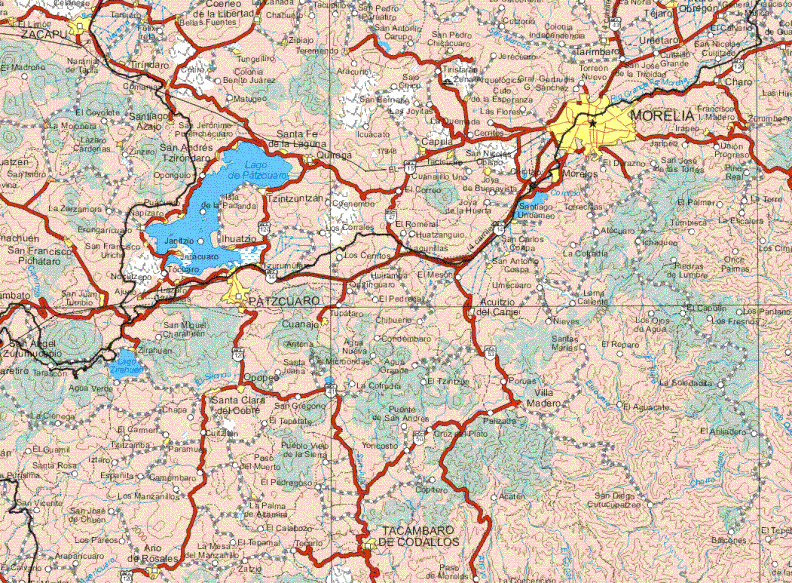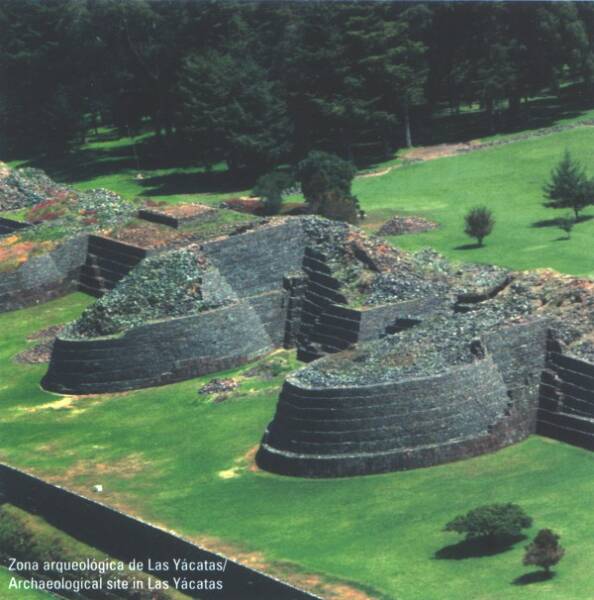Lake
Patzcuaro
Tzintzuntzan is a city in the state of Michoacán, Mexico, Tzintzuntzan stands on the eastern shore of Lake Pátzcuaro, about 15 km north of the city of Pátzcuaro and about 60 km west of state capital Morelia, and at some 2050 m above sea level. It serves as the administrative seat for the surrounding municipality of the same name.
 | ||||||
Tzintzuntzan
The Pre-Columbian city of Tzintzuntzan stands on a hillside above the modern town. The remains of many step pyramids of a design typically used by the P'urépecha in their ritual buildings are known locally as yácatas, by extension, the present-day archaeological site is also known as "Las Yácatas". The Tzintzuntzan yácatas are of several different shapes, some rectangular, some oval or circular, and others in the distinctive Tarascan "T" shape. The population of the ancient city is estimated to have peaked at somewhere between 25,000 to 35,000 people.
The population of the entire Lake Pátzcuaro basin was between 60,000 to 100,000, spread among 91 settlements of which Tzintzuntzan was the largest.
Tzintzuntzan was still the P'urhépecha capital when the Spaniards arrived in 1522. First contact, led by Nuño de Guzmán arrived in 1529, Chieftain Tangaxuan II was burned alive and the city largely dismantled to provide stones for Roman Catholic temples and civic buildings, most notably the large 16th century Franciscan Monastery of Santa Ana. Following the disgrace and recall of Nuño de Guzmán, Vasco de Quiroga was sent to the region, and Tzintzuntzán served as the headquarters of Spanish power in the area until the bishopric was relocated to Pátzcuaro in 1540.
BellaOnline
The voice of Woman
Les Shulman, Mexico Editor
http://www.bellaonline.com/articles/art26972.asp
Tzintzuntzan "Place of the Hummingbirds"
Surrounded by hills and mountains, the watershed of the state of Michoacan’s lovely Lake Patzcuaro extends 50 kilometers east-west and 33 kilometers north-south. Ringing the 2200 meter above sea level lake are numerous Purepecha (known commonly as Tarascan) villages and towns. Far and away, as it literally is about a seven hour round trip by bus from my house, my favorite of these indigenous lakeside communities that I have visited is the tiny village of Tzintzuntzan (seen Soon sahn). From my perspective (more about this later), any place with such an avian onomatopoeic name must be interesting and it delightfully is.
Approximately 50 kilometers from the state capital of Morelia this indigenous village with buildings lining its one main street made mostly from adobe painted in the traditional white wash with red trim and red tiled roofs is located 14 kilometers north from the beautiful indigenous and colonial large town of Patzcuaro and 7 kilometers from the not so beautiful crafts and carnitas/braised pork town of Quiroga. Having only a couple of hotels, Tzintzuntzan is a very popular day trip destination for Mexican tourists and to a lesser degree foreign tourists primarily on the weekends and especially during the two days of the Day of the Dead celebrations. There are three major attractions that the majority of visitors come to experience.
Only a couple of minutes walk from the village’s attractive long and narrow zocalo/main plaza is the Ex-Convento de San Francisco, a religious/monastery complex that has been undergoing extensive renovations since 2000 whose buildings date back from the 1500's-1600's; these edifices were partially constructed from the quarried rocks that came from the nearby Purepecha temples and platforms that were demolished by the conquering Spanish. There are four buildings on the expansive grounds: the Templo/Church de San Francisco that was built exclusively for the monks that features faded frescoes/murals and openwork wooden Moorish panels; the Templo de Nuestra Senora de la Salud which contains the Santo Entero, a much revered wax image of Christ displayed in a glass casket; and two open capillas/chapels. While I find the buildings quite fascinating what I most like about the complex are the grounds themselves with its tall antique cherub decorated street lamps, an original stone cross from the 16th century, and especially the atrium with its beguilingly gnarled olive trees some of which dating back to the 1500's are said to be the oldest in the America’s.
Just a kilometer from the center of the village on the side of a hill is the Tzintzuntzan Archaeological Site. Until the Spanish Conquistadors vanquished them in 1522, Tzintzuntzan had been the capital of the Purepecha Empire (circa 1200AD-1522AD). While always remaining autonomous from the Aztecs the empire had under its control approximately 1.5 million people at the height of its power. Now, this ex-ceremonial center with a platform measuring 425 meters by 250 meters and its 5 yacatas- the unusual Mesoamerican semi-circular bases constructed from non-mortared basalt slabs that were the foundations for the long ago destroyed wooden pyramids/temples built on top of them- is all that remains of that empire. Although not as physically impressive (nor accessible as you may not climb on any of the fenced off yacatas) as the more famous, extensive, and “inward” looking Mexican archaeological sites like Monte Alban, Chichen Itza, or Teotihuacán, I find this “outward” looking site to be visually quite compelling. From this hill with the yacatas as a unique historical backdrop one is afforded an outstanding panoramic view of the village below and of Lake Patzcuaro off in the distance. Also, there is a one room, albeit not particularly well lighted, museum near the entrance that exhibits excavated pottery/ceramics, obsidian artifacts, and a diorama of the site.
Yet, back in town, what attracts the most tourists are the crafts that the village is known for. Although its craft market next to the monastery complex and artisan stores along its main street are open seven days a week, the crafts scene is most vibrant and full with vendors on the weekends, especially Sunday. There, among a plethora of mostly locally made goods you can find woven tule/lake reeds items, both high-end ceramics and inexpensive pottery including its famous green glazed pieces, rebozos, embroidered textiles with pre-Hispanic motifs, objects made from vegetable fibers, rustic wood furniture, basketry, and dozens of items woven from straw including brilliant strands of Christmas decorations like stars, candy canes, and mini wreaths along with more straw merchandise like lamps, tortilleros/tortilla warmers, wind chimes, and sea shells. Moreover, on the road leading into town from Patzcuaro are stonework shops that have decorative and landscaping pieces made from the pinkish rock cantera like ornate fountains and whimsical-looking fish, frogs, and turtles.
However, while I enjoy all of the three major attractions that Tzintzuntzan offers, the primary reason that I travel so far to get there is for its bird watching opportunities, particularly in the winter. In the indigenous language, Tzintzuntzan onomatopoeically means “place of the hummingbirds.” While it is true that during the time of the Purepecha Empire that these diminutive birds were driven to extinction due to the desirability of their iridescent feathers for use in clothing and jewelry, it is also true that they and dozens of other species of birds now occur in Tzintzuntzan. In town the best places to view birds is at the Ojo de Agua and the small public embarcadero. The archaeological site with its pine-oak grove is also an excellent birding spot.
Whether you are a birder or not, Tzintzuntzan is an indigenous lakefront town that is well worth a visit. Who knows, while in the Zocalo and enjoying its traditional ambiance, you might experience what I did the last time that I was there --- the tz-tz-tzing of hummingbirds, tz-tz-tzing to and fro in a flower garden.


